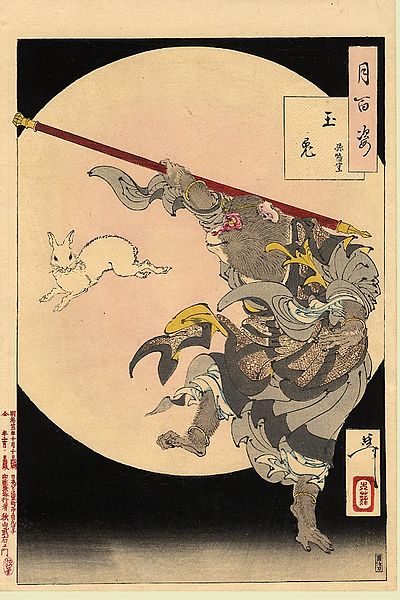Even these Chinese Vedic relics highlighted here only survived having been recycled into other buildings but countless artifacts confirming the Vedic presence in China were intentionally destroyed by Mao in his 'Cultural' Revolution.
The late Professor Huang Xinchuan of the Department of Oriental Philosophy in Beijing University, stated that once China had many Vishnu and Shiva Temples as well as many evidence regarding China's Vedi past.
He also clearly stated that the Monkey King, Sun Wukong, is Hanuman.
The fact is wherever you find a strong Buddhist presence you will have an earlier Vedic/Hindu presence. As it was in Myanmar, Thailand, Cambodia Vietnam or Indonesia, or the Philippines it was in China, Mongolia and Japan - they all had a strong native indigenous expressions of Hindu art and culture.
The Buddhist missionaries from India came not to convert but reveal the latest expression of Dharma. They did not work in a cultural vacuum with a people unfmiliar with Dharma or Sanskriti. Rather Buddhism was recognized as a new wave of the same ocean and thus it spread rapidly.
Mainstream scholars have the idea that only the Tamil residents in China were Vedic worshipers but it is not entirely true. Today, India is still called Bharat but it only represents an extremely truncated Bharat. True Bharat is the entire world and this Vedic culture is the entire humanity's heritage, as said in Tamil, 'yaathum oore, yaavarum kelir' which means the world in my country and I'm a global citizen.
As we see in India so many reflections of the same culture, Krishna as Jagannath is the same Rama is the same Tirupathi is the same Narasimha is the same Chaitanya is the same Buddha is the same Vamana is the same Varaha etc. This phenomenon once extended globally.
Now we have a culture called 'Indian' based upon the Greek name for a river, the Indus, that was not even remain within the boundaries of India. Thus Bharatiya is used yet according to the Vedic scriptures Bharat was originally global. It is my opinion that the region of modern India was the epicenter and capital but everyone be they yavanas, kiratas, hunas, shakas, chinas etc were all equal members of Bharat. Thus, they fought for the same cause in the Mahabharat war. India's saints have faithfully recorded the characteristics of Krishna and true Vedic culture and by using that template we can trace out evidence of Krishna and Shiva worship throughout the entire world.
All this Vedic culture is primal and India preserved the ancient truths as the rest forgot. Just as the whole world was once Bharat, including the Sindh region of Pakistan - today we see how Vedic culture has been basically decimated from that formerly 'Indian' region. Even Christopher Columbus set sail to find India and ended up discovering America instead - what was the name that was accorded to the natives of America? Red Indians.
So this same divisive process that we see happening in recent history happened globally as Kali Yuga progressed. God and the Devas are universal realities; they have authentic markers that trace their presence whenever revealed or experienced. Thus, Krishna is Krishna with the same qualities and characteristics wherever he has revealed himself. Though he performed his lila, along with Buddha in India, he is not an Indian invention and some have stated that he traveled far beyond the borders of modern India as well. The Pandavas surely did before the Rajasuya Yajna. The Rishis have faithfully recorded Krishna's characteristics and thus evidence of his worship and presence can be accurately traced throughout history.
There is no minimizing the impact and influence of India's great Saints and culture. But rather than a conversion force India had a reinforcing influence that repeatedly revived the world's ancient Vedic heritage in all its expressions. This is ongoing even today - we, thus, have many non-Indian Vaishnavas and Yogis in China and elsewhere but it was Indian Gurus, books etc that guided them and still guiding them. However they do not guide them on how to be Indians but on how to revive their original traditions and intersperse Hindu tenets into their own indigenous culture. These indigenous expressions of the Vedic traditions are the same universal truths that have been carefully preserved and maintained within the Vedic Sampradayas currently in India.
And now by applying the template and Siddhanta of these Sampradayas, lo and behold, we can find ancient and at times ongoing examples of Vedic culture globally. This is not because Indians traveled the world promoting and converting people. Its because Vedic culture and Worship was once practiced throughout the entire world. The ancient presence of Vaishnavism and Shaivism (along with related Devi Worship) can be found at at the root of every ancient cultural group on the planet. The Indians that have traveled the world as ambassadors of these traditions represented the lineages that maintained these traditions. Thus they were able to revive the natural Vedic culture that is inherent in all Bharaters (Brothers) or People of Bharata, on this Blessed Planet Earth.
Related articles:
Related articles:
- Why should you be proud to be a Hindu
- Hinduism, the most tolerant religion in the world
- Hindu association: No more Manchester United logo on kavadis in Thaipusam
- The truth about Dharma, the righteous path
- How Hindu mythology contribute to rape in India
- Wastage in the name of God
- Thaipusam: How Hindus are getting it wrong
Don't forget to share with your friends and colleagues
You can leave your comments below, in the Comment Section. We like to have a healthy debate here. Please avoid profanity, personal attacks and rouse racial and religious sensitivity. The views of the commentators are not shared by Both Coin. The bottomline is, comment sensibly with relevance to the article.











.jpg)

























